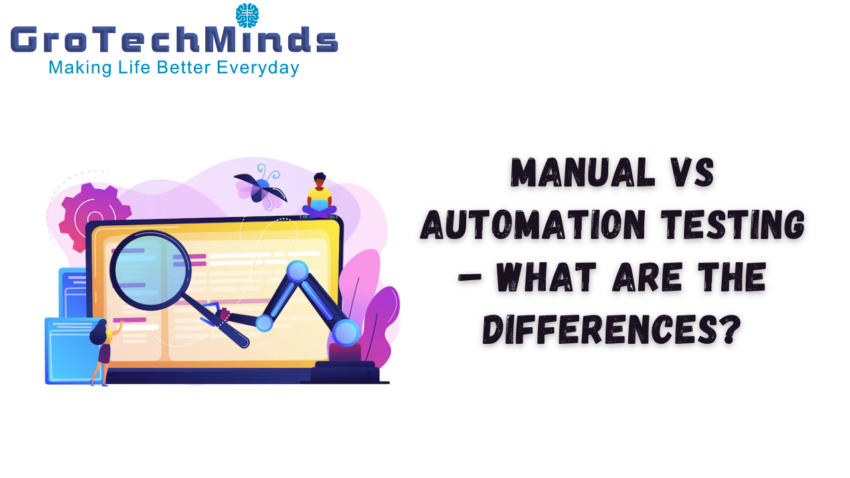Introduction:
Software testing is a crucial phase in the software development life cycle, ensuring that applications meet quality standards. The choice between manual and automation testing is a perennial topic in the industry. At GroTechMinds Software Ltd, we understand the nuances of these testing methodologies and recognize the need for a balanced approach to deliver robust software solutions. This comprehensive guide explores the key differences between manual and automation testing and outlines the specific advantages each brings to the testing process.
Understanding Manual Testing:
Hands-On Approach:
- Manual testing involves human testers executing test cases without the aid of automation tools. It is a hands-on approach that allows for detailed exploration of an application’s functionality, user interface, and overall user experience.
Exploratory Testing:
- One of the significant advantages of manual testing is its effectiveness in exploratory testing. Testers can follow their intuition and adapt to changing requirements, making it ideal for scenarios where creativity and adaptability are crucial.
Visual and Usability Inspection:
- Manual testing is adept at identifying visual and usability issues that might be challenging for automated scripts to detect. This is particularly valuable in assessing the overall user experience of an application.
Effective for Small-Scale Projects:
- In certain situations, particularly with smaller projects or projects with frequently changing requirements, manual testing can be more cost-effective than setting up and maintaining an automated testing framework.
Manual Testing at GroTechMinds:
At GroTechMinds Software Ltd, we recognize the value of manual testing in ensuring the highest quality for our software products. Our skilled manual testers meticulously assess every aspect of an application, from its basic functionality to the most intricate details of user interactions.
Advantages of Manual Testing:
Flexibility and Adaptability:
- Manual testing offers flexibility and adaptability, making it well-suited for projects with changing requirements and agile development methodologies.
Cost-Effective for Short-Term Projects:
- In scenarios where the project scale is limited, and the development cycle is short, manual testing can often be more cost-effective than setting up and maintaining an automated testing infrastructure.
Effective for Exploratory Testing:
- Human intuition is invaluable in exploratory testing, allowing testers to uncover unforeseen issues and potential improvements in real-time.
Understanding Automation Testing:
Tool-Based Execution:
- Automation testing relies on specialized tools and scripts to execute test cases. It is particularly effective for repetitive tasks, regression testing, and scenarios with large datasets.
Regression Testing and Efficiency:
- Automated tests excel in regression testing, where repeated execution of test cases is necessary. They provide quick and efficient feedback on software changes, reducing time-to-market.
Scalability:
- Automation testing is highly beneficial for projects with large codebases or frequent updates. It ensures efficient regression testing and overall stability of the application.
Automation Testing with Selenium Course:
As part of our commitment to fostering expertise in software testing, GroTechMinds Software Ltd offers an exclusive “Automation Testing with Selenium Course.” This course is designed to equip professionals with the skills required to excel in automated testing, with a specific focus on the widely-used open-source automation tool, Selenium.
Key Topics Covered in the Course:
Introduction to Selenium and Automation Testing:
- Understand the fundamentals of Selenium and its role in the broader field of automation testing.
Setting Up Selenium Environment:
- Learn the practical aspects of setting up a Selenium environment for effective test automation.
Writing Selenium Test Cases:
- Master the art of writing Selenium test cases to ensure comprehensive test coverage.
Selenium WebDriver and Its Functions:
- Explore the capabilities of Selenium WebDriver and its functions in automating web applications.
Handling Different Types of Web Elements:
- Understand how to effectively handle various web elements to create robust and reliable test scripts.
TestNG Framework for Selenium:
- Dive into the TestNG framework, a crucial component for efficient test management and execution.
Data-Driven Testing with Selenium:
- Learn how to implement data-driven testing with Selenium for enhanced test scalability and coverage.
Automation Frameworks and Best Practices:
- Explore different automation frameworks and best practices to streamline the automation testing process.
Advantages of Automation Testing:
Repeatability and Consistency:
- Automated tests ensure consistent execution, reducing the chances of human errors and providing reliable results.
Efficiency and Time-Saving:
- Automated tests can be executed faster than manual tests, allowing for quicker feedback on software changes and reducing time-to-market.
Scalability:
- Automation is highly beneficial for projects with large codebases or frequent updates, as it allows for efficient regression testing and ensures the stability of the application.
Conclusion:
Explore the differences between Manual and Automation Testing in our easy-to-read blog! Discover the strengths and weaknesses of each method. If you want to know more, take our manual testing full course. Join our online classes to learn and make smart choices in your testing adventure. Understand the distinctions and find what works best for successful testing!


